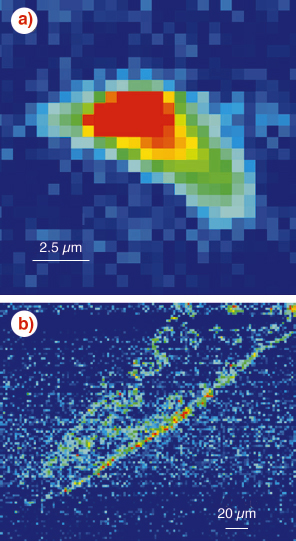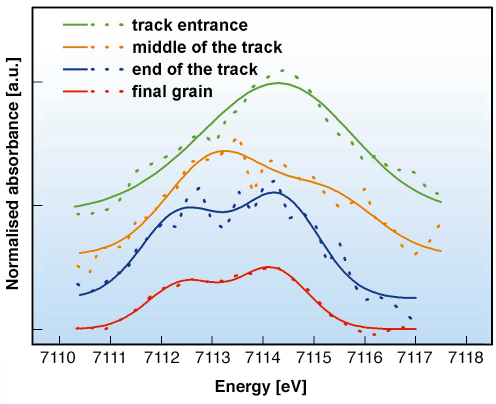- Home
- Users & Science
- Scientific Documentation
- ESRF Highlights
- ESRF Highlights 2005
- X-ray Imaging and Optics
- In situ Fe XANES on Extraterrestrial Grains Trapped in an Aerogel for the Stardust Mission
In situ Fe XANES on Extraterrestrial Grains Trapped in an Aerogel for the Stardust Mission
In January 2006, the NASA Stardust mission will bring aerogel collectors back to Earth in which grains of the comet Wild-2 as well as interstellar grains have been trapped. In order to develop an analytical protocol, micrometre-sized grains trapped inside pieces of aerogel were analysed. The pieces of aerogel, called keystones, were a few hundreds of micrometres large. They originate either from the NASA Orbital Debris Collection Experiment (ODCE) exposed outside the Mir station for 18 months from 1997 to 1998 (samples LC01B2, 2D0403 and 2D0401), or from gas gun shots in Stardust’s aerogel of grains from the Allende meteorite (sample 8JUN05B). Micro-fluorescence mappings and XANES spectra at the iron K-edge have been performed on these samples using the X-ray Microscopy beamline ID21.
From the micro-fluorescence mappings performed on the ODCE samples, both the final grain and the penetration track were identified (Figure 156). It can be concluded from the Fe “hot spots” found along the track that the incident grain broke up into many fragments while entering and slowing down in the aerogel in spite of its low density (0.02 g.cm-3). For the other sample 8JUN05B, the only material found along the track is in the form of iron beads coming from the barrel of the dust gun, confirming that Stardust’s aerogel, characterised by a gradient of density, is suitable for slowing down hypervelocity particles. The efficiency of a new technique consisting in cutting the keystone along the penetration track was verified on the sample 2D0401 by imaging the track and the final grain both exposed to the air by this preparation. This allows coupling X-ray analyses with other analytical techniques like Raman and IR microspectroscopies since the beam no longer needs to pass through the aerogel.
 |
|
Fig. 156: Fe distribution in 2D0401: (a) The final grain 4 µm in size. (b) The penetration track, about 250 µm long, with a spatial resolution of 2 µm. |
In a previous experiment, we showed with LC01B2 that the redox state of iron varies from the entrance of the track (Fe3+) to its end and the final grain (Fe2+) [1]. In order to confirm this, XANES spectra at the Fe K edge were acquired in hotspot regions of each sample using a Si(220) monochromator with an incident energy ranging from 7.1 to 7.28 keV in steps of 0.25 eV. The synchrotron X-ray source was demagnified using Fresnel zone-plate lenses and the beam size at the sample was 0.5 x 0.5 µm2. For each spectrum, the energy of the absorption edge and the centroid energy of the pre-edge (intensity-weighted average of each component energy) were used to determine the Fe redox states, following [2]. Results are summarised in Table 3.
 |
|
Table 3: Edge and pre-edge characteristics of Fe-XANES spectra. |
The edge and the pre-edge centroid (Figure 157) evolve towards a reduced form (Fe2+) from the track entrance to the end of the track and the final grain. Beam-induced photo-reduction was checked for by acquiring several spectra on the same points and seeing no shift towards lower energies.
 |
|
Fig. 157: Normalised pre-edge features of absorption spectra in different region of 2D0401. The data are represented by a dotted line and the fit of the pre-edge by a solid line. |
Given the observed Fe redox state of the particles in the aerogel, several mechanisms can be inferred. Most probably, incident grains of 2+ oxidation state undergo rapid oxidation to 3+ at the entrance of the track, due to high temperature slowing down from the initial velocity of a few km.s-1 in the presence of the aerogel oxygen. The shell of oxidised iron is lost at the track entrance by the grain that remains in the 2+ oxidation state at the end of the track.
In conclusion, fluorescence imaging using the ID21 SXM was succesful in locating the residual impacted grain and the substantial fraction of matter spread along the penetration track. Furthermore, Fe K-edge XANES allows precise studies of the redox reactions associated with the grain slowing down in the oxygen-rich aerogel.
References
[1] J. Borg, Z. Djouadi, F. Grossemy, D. Eichert, G. Martinez-Criado, A.J. Westphal, D. Deboffle, C.J. Snead and A. Somogyi, Advances in Space Research, in press (2005)
[2] M. Wilke, F. Farges, P-E. Petit, GE. Brown Jr and F. Martin, Amer. Min., 86, 714-730 (2001)
Principal Publication and Authors
F. Grossemy (a), J. Borg (a), Z. Djouadi (a), A. Simionovici (b), L. Lemelle (b), D. Eichert (c), D. Deboffle (a).
(a) Institut d’Astrophysique Spatiale (IAS), Université Paris-Sud 11 and CNRS, Orsay (France)
(b) Laboratoire des Sciences de la Terre (LST), ENS Lyon (France)
(c) ESRF



